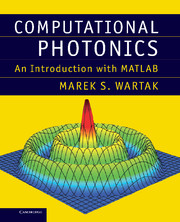Book contents
- Frontmatter
- Contents
- Preface
- 1 Introduction
- 2 Basic facts about optics
- 3 Basic facts from electromagnetism
- 4 Slab waveguides
- 5 Linear optical fibre and signal degradation
- 6 Propagation of linear pulses
- 7 Optical sources
- 8 Optical amplifiers and EDFA
- 9 Semiconductor optical amplifiers (SOA)
- 10 Optical receivers
- 11 Finite difference time domain (FDTD) formulation
- 12 Beam propagation method (BPM)
- 13 Some wavelength division multiplexing (WDM) devices
- 14 Optical link
- 15 Optical solitons
- 16 Solar cells
- 17 Metamaterials
- Appendix A Basic MATLAB
- Appendix B Summary of basic numerical methods
- Index
7 - Optical sources
Published online by Cambridge University Press: 05 July 2013
- Frontmatter
- Contents
- Preface
- 1 Introduction
- 2 Basic facts about optics
- 3 Basic facts from electromagnetism
- 4 Slab waveguides
- 5 Linear optical fibre and signal degradation
- 6 Propagation of linear pulses
- 7 Optical sources
- 8 Optical amplifiers and EDFA
- 9 Semiconductor optical amplifiers (SOA)
- 10 Optical receivers
- 11 Finite difference time domain (FDTD) formulation
- 12 Beam propagation method (BPM)
- 13 Some wavelength division multiplexing (WDM) devices
- 14 Optical link
- 15 Optical solitons
- 16 Solar cells
- 17 Metamaterials
- Appendix A Basic MATLAB
- Appendix B Summary of basic numerical methods
- Index
Summary
In this chapter, we will give a basic introduction to optical sources with the main emphasis on semiconductor lasers. The bulk of our description is based on the rate equations approach. We start with a general overview of lasers.
Overview of lasers
Generic laser structure is shown in Fig. 7.1 [1], [2]. It consists of a resonator (cavity), here formed by two mirrors, and a gain medium where the amplification of electromagnetic radiation (light) takes place. A laser is an oscillator analogous to an oscillator in electronics. To form an oscillator, an amplifier (where gain is created) and feedback are needed. Feedback is provided by two mirrors which also confine light. One of the mirrors is partially transmitting which allows the light to escape from the device. There must be an external energy provided into the gain medium (a process known as pumping). Most popular (practical) pumping mechanisms are by optical or electrical means.
Gain medium can be created in several ways. Conceptually, the simplest one is the collection of gas molecules. Such systems are known as gas lasers. In a gas laser one can regard the active medium effectively as an ensemble of absorption or amplification centers (e.g. like atoms or molecules) with only some electronic energy levels which couple to the resonant optical field. Other electronic states are used to excite or pump the system. The pumping process excites these molecules into a higher energy level.
- Type
- Chapter
- Information
- Computational PhotonicsAn Introduction with MATLAB, pp. 167 - 203Publisher: Cambridge University PressPrint publication year: 2013



